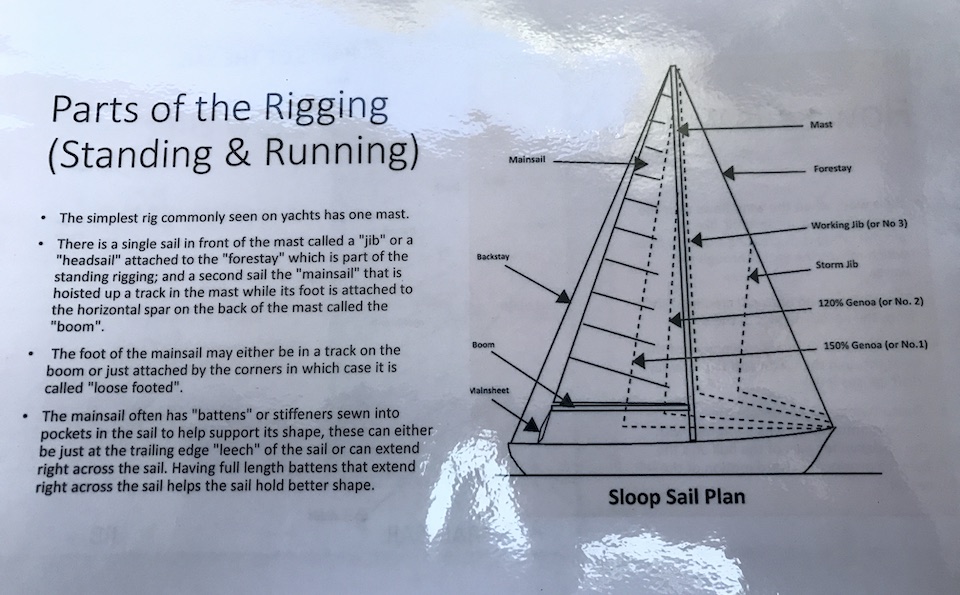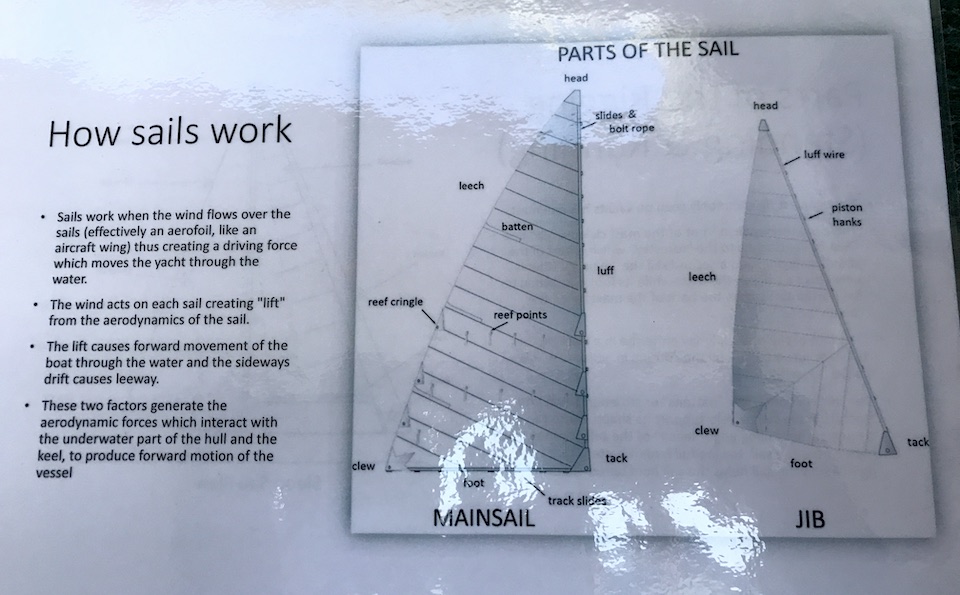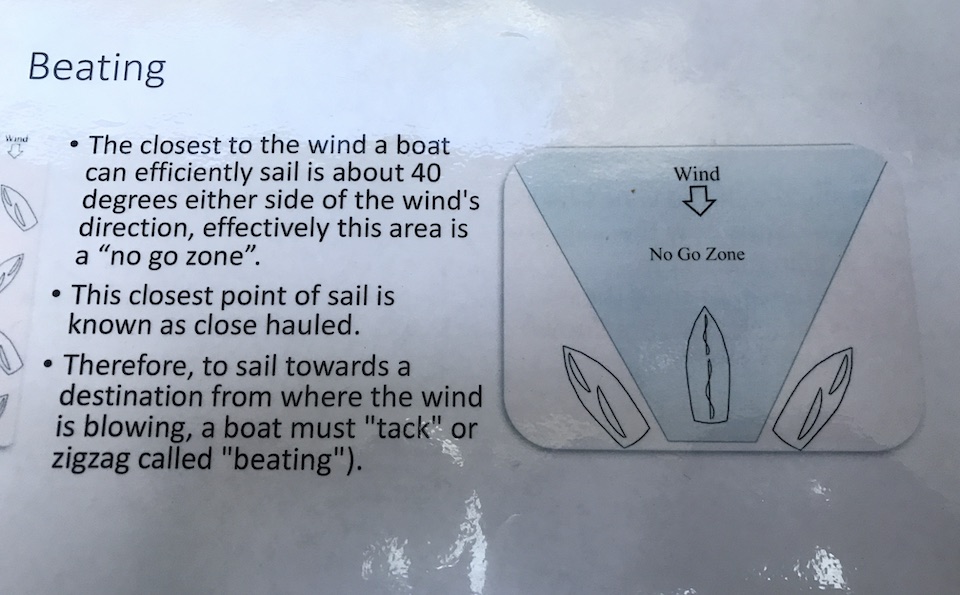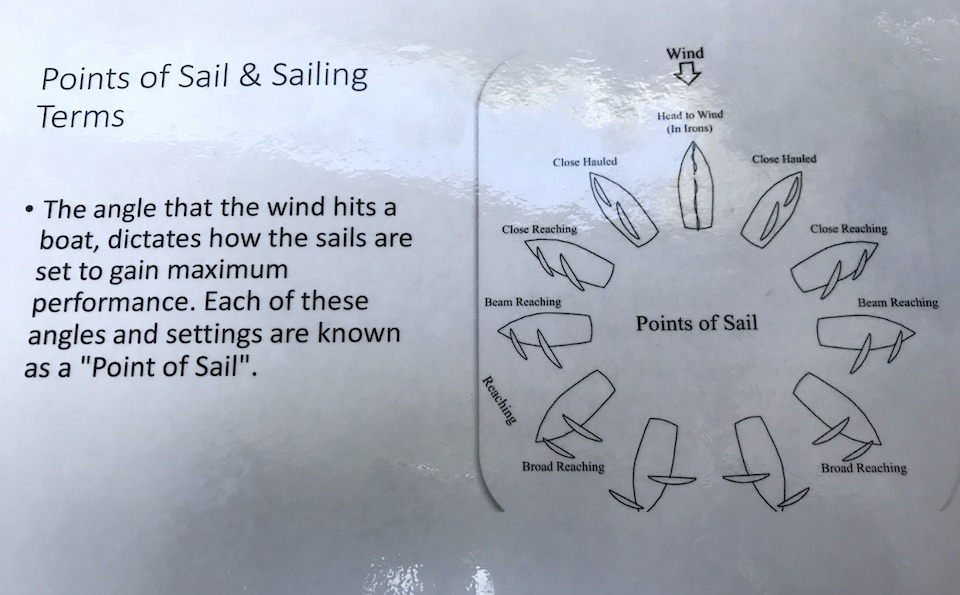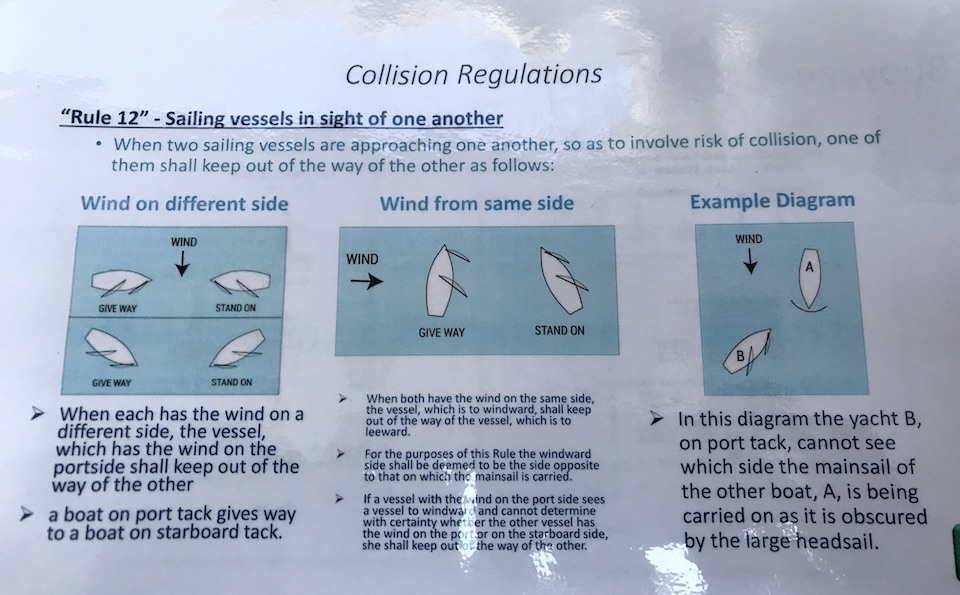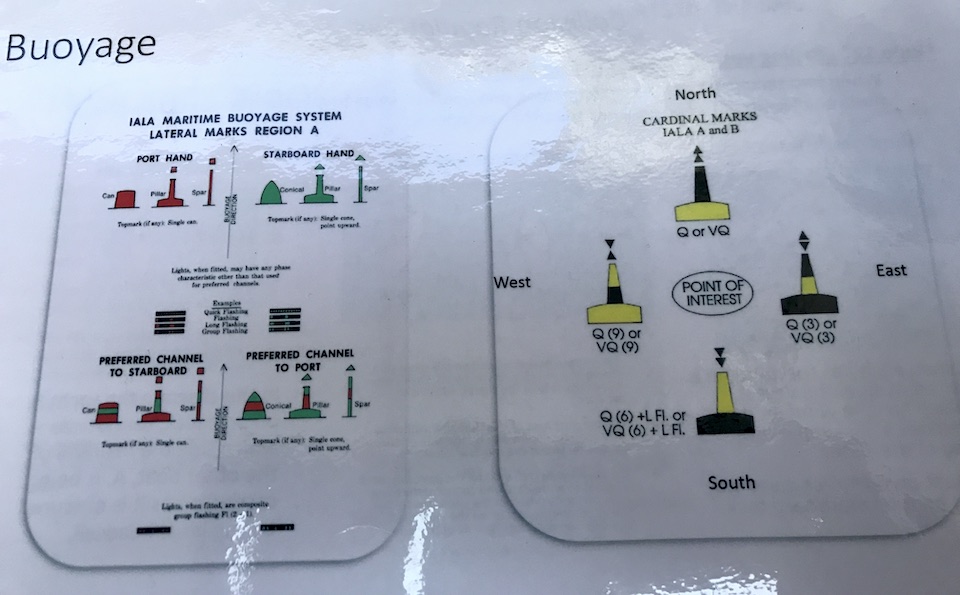First we had to find a place to get some basic instruction – a quick Google on the best places to learn to sail in the world pointed to New Zealand’s Bay of Islands, coincidentally the place where Wayne’s mum lives and our next travel destination. Then reading about Great Escape and their positive reviews set the sails in motion. We went ahead and booked a 2 day IYT Intro to Sailing course, including a night spent on the boat, for $445 NZD per person. All we had to do then was turn up at the dock on the Sunday morning with food, bedding and a fun attitude – we were super excited to begin tacking and gybing.
Hopefully come 48 hours later we would have mastered the following…
-
- Hazards, equipment, parts of the boat and sailing definitions
- Hoisting and changing the mainsail and basics of sail trim and tell-tale use
- Avoiding collisions and recovering a person overboard
- Understanding weather forecasts and the clothing suitable for different conditions
- Learning a variety of knots and their uses (I’m a mountaineer so know a thing or two about knots!)
- Performing all roles associated with tacking, gybing and other crew positions of a boat
- Knowledge of the ‘Give Way’ rules
Our instructor, a German Kiwi had done all that sailing could offer; sailed around the world, crossed the Pacific twice (once alone), and countless trips around the islands of the South Pacific. We were in safe hands! We had a couple of options on the boat, eventually deciding on the 6.1 metre Davidson 20 – the 7.7 metre Noelex 25 was $100 NZD more per person and we’re far too cheap for that!
Finally, the destination. We’ve visited here numerous times and the scenery is stunning. Does there need to be any other reason? The Bay of Islands is situated in the north of New Zealands north island, is protected by multiple islands offering good anchorage, and to top it all has, the perfect climate.
Day 1
Our first hazard was maneuvering between various sized sailing boats to get out of Opua bay – we didn’t need sails or a wind for this, just a tiny 8HP outboard dangling from the back, I mean stern, of the boat. Some initial guidance from the captain and we were out in the main channel eagerly awaiting further instruction. This was instantly appearing to be Andrea and I doing all the work with the captain providing minor details regarding keeping us afloat and harnessing the wind. What a relaxing day on the water.
Once out in an area away from too much other boat traffic it was time to switch from outboard to wind power. Now the biggest problem with good weather, especially in the mornings, is that there’s always the possibility for conditions to be too calm – this is ideal when being shown how to set the main and jib sails but not so good when forward movement is required! On the other hand too much wind too early on day 1 would have caused us all sorts of problems. It was already a battle to remember to watch out for the boom potentially swinging across the boat knocking us overboard. Lesson 1; watch that boom!
First we had to find the wind, the tricks being to feel it, look for it on the surface of the water, and luckily for us, just to look at the direction of the spinning arrow on the top of the mainsail. It was going to take time for the senses to awaken to the first two, although a good smack on the head from the boom whilst continuously looking up would quickly awaken those senses!
So, our limited knowledge so far…
-
- The location of port and starboard
- How to pick up a man overboard whilst on motor
- That we should point the boat into the wind to set sails
- How to set the main and jib sails
- 25% towards knowing how to tie a bowline
- Judging wind direction
- Basic etiquette and rules of the water
Continuing onwards… we were now running downwind (that’s the same direction as the wind is going!) at somewhat of a snail pace. This was mostly to do with the lack of wind but could be tweaked to take advantage of what was available – this is known as trimming and is definitely where things were going to take some significant practice for the both of us. I was hoping Andrea would ‘get it’ so I didn’t have to!
Understanding the different Points of Sail, or as per wikipedia… a sailing craft’s direction of travel under sail in relation to the true wind direction over the surface, was a step in the right direction for us to attempt to make the necessary adjustments for forward momentum. We also needed to understand the difference between true wind and apparent wind, the latter being what acts on the sail.
Excerpt from garmin,com…
If an instrument for measuring the speed and direction of the wind is mounted on shore, then the readings obtained are those of the speed and direction of the true wind. If we take this same instrument, and mount it on a boat that is moving through the water, then the reading will be quite different from those taken on shore. These readings show the speed and direction of the apparent wind relative to the boat. The term “relative to” is used because the apparent wind is applicable only to the particular boat we are looking at and is not the same for other boats sailing in the same area.
If the true wind is blowing at 20 knots from the south and the boat is traveling at 15 knots in a southerly direction, then the wind speed measured on the instrument will be the sum of the two speeds (35 knots) and the direction of the wind will be from the south. Similarly, if the boat is traveling at 15 knots in a northerly direction, then the wind speed measured will be the difference between the two speeds (5 knots) coming from the south.
It is the apparent wind that acts on the sail, not the true wind. and that is why it is so important to understand how it behaves.
As the morning progressed so did the wind, distant ripples on the water providing a hint that we would soon be moving just a little faster. Unfortunately with our boats top sailing speed being only around 5 knots we were never going to be hauling ass! The ripples did in fact come closer and closer to our position as the winds entered the bay, soon causing our main and jib sails to flap and fill with the fuel of movement. We were sailing!
Sailing directly with the wind was easy, both sails in a wing and wing position giving us a stable ride. It was nice to have our guide remind us of the potential danger of moving a few degrees from this course, the threat being the main sail boom swinging across and knocking one of us into the Pacific. From this position it was time to begin changing course, with the new heading towards a cruise ship monstrosity moored in the opening of the bay. Whilst still sailing in a downwind direction we had to now execute a series of gybes (jibes) – this maneuver being similar to a tack which would be upwind.
Owing to a lack of technical boating jargon the procedure went something like this… A verbal warning of “prepare to gybe”, followed by a team member putting the rudder over from one side to the other, and a duck of the head as the boom was swung across the centreline of the boat to its opposite side. In simplistic terms we were now sailing in a Broad Reaching point of sail at around 45 degrees from directly downwind. This was not rocket science but we were struggling to ‘get it’.
All we seemed to be doing was whatever we were told, never quite understanding the reasoning behind the moves. We understood that we had to duck our heads and how far to shift the rudder to change course, but beyond that, reading the wind and trimming the sails was slightly confusing! Maybe this is what happens when growing up in Leicester and Lexington, both cities far from their respective countries oceans.
The return to our nights dockage wasn’t much easier; tacking back and forth against the wind, seemingly making no forward motion. Part of the reason this was all so confusing was that we didn’t understand sails, really only assuming that the wind pushed against the sail causing forward motion. We were to find out that there was far more to it, with aerodynamics, hydrodynamics, lift and force all playing a part. Additional reading was required after a brief explanation from our captain didn’t quite make its way to the understanding part of the brain! Still, at least now we know what we need to learn.
By far the easiest part of the day was dropping the sails and switching to power as we made a passage through the moorings to our nights dockage. This was where more learning was necessary; how to row a tiny plastic dinghy without going round in circles!
Day 2
Would our second day on the water be any better? Could our new American skipper steer us in the right direction and with his different learning style could we get a grasp of sailing? Only the next 8 hours would tell. Just as the previous day we made our way out of the harbor without incident, soon stopping to set sails and catch the pathetic amount of wind – I can honestly generate more wind from a fart! The first couple hours were a waste but did ensure we got to know our captain a bit better.
Gradually, just like the prior day, things did get moving as the winds moved in from the open ocean. Seeing other boats beyond the protection of the bay with full sails gave us hope! This also meant that we would have to show our new instructor what we had learnt – luckily the criteria for getting through this course was far from advanced, little more than a few ticks against certain skills.
Not sure how apparent it was but when we were told what to do and how to do it everything went well, whereas being asked what needed to be done next our reply was often the opposite of what was expected. It was still a lot of fun being out on the water gaining some familiarity with a sailing boat and comfort with what is typically a far from uncomfortable activity. Even if persistent instruction was necessary our tacks and gybes were happening and we were making progress beyond the bay and out into the beauty of the Bay of Islands proper.
Our goal was Motuarohia Island, the perfect place for a lunch and photography stop. We had come considerably further than the prior day, and with it an enjoyment factor far greater than either of us imagined. The sun, the water and the amazing beauty of this small cluster of New Zealand islands just couldn’t have been better.
Dropping anchor a 100 metres from shore checked us another box – more of a skill than we would have expected. Also a pretty big deal if you don’t get it right, the potential to be smashed against rocks or grounded on a shallow reef in stormy conditions very possible! After an out and back rowing palaver from Andrea and to finish the day we now only had to get back to Opua. This was still a couple hours of jibing away.
With the wind generally coming from our backs, in sailing terms headed in a downwind direction, points of sail switching between a Beam and Broad Reach, our little boat and its crew of three made comfortable work of the distance back to where we’d switch to motor. We would definitely need to learn these points of sail and how to trim the sails to take advantage of the different directions relative to the wind, somewhat important if we decide to continue with further education.
The final simple test for the day would be whether we could bring the boat up nicely against the Great Escapes dock, avoiding other boats in the process and trying not to slam into the buoys. This required some gentle motor control, easy on the rudder, and an interpretation of the wind and tide direction – with continual instruction from our skipper heavy impact was avoided and the boat came to an easy stop up against the dock. We certainly wouldn’t want to put ourselves into a position where we would have to accomplish this task by ourselves!
We’re super stoked with the opportunity to experience the world of sailing and doing it through Great Escapes and their excellent guides. Yes, the weather was almost too calm with no possibility of becoming seasick but this intro to learning to sail has created an entirely new way for us to further our wings and see more of planet earth. No doubt there is much more room for improvement but we had to start somewhere! Now so as we don’t forget what we’ve learnt we need to go buy the 68th edition of Chapman Piloting and Seamanship.
Where will our new found water based pastime take us next – watch this space….
2 day Intro to Sailing course with Great Escape Sailing (Opua), Cost: $445 NZD pp
Dates
January 19th – January 20th 2020
IMAGES
I think that with trial and error both my photography and website design are getting progressively better so hopefully these newer, better quality images will inspire you to get out there and travel. Click HERE to see more and if you like the content then feel free to comment.



